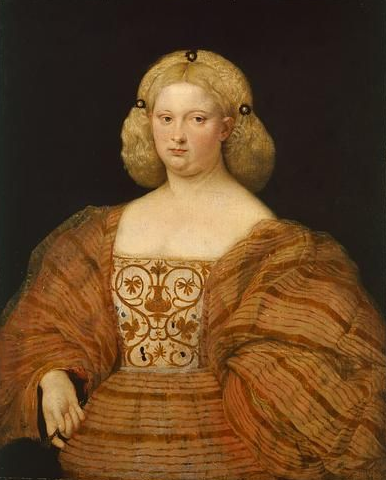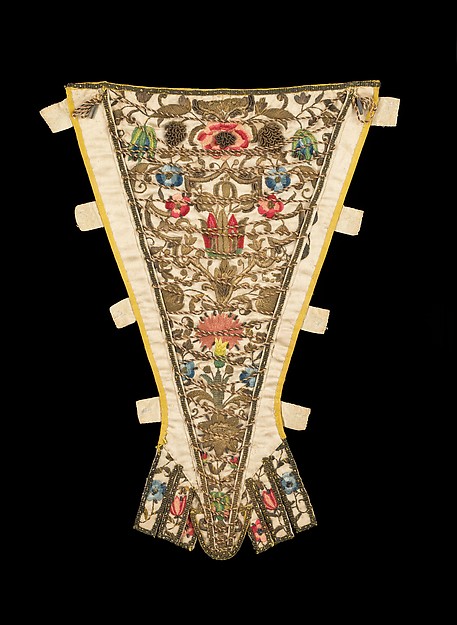Just Let me Pin on My Flat, Frilly, Fancy Abs…
Stomacher and matching Gown, mid 18th century
Stomachers were an essential part of a woman’s wardrobe beginning with a rise of pairs of bodies and stays (the ancestors of the corset). There is evidence that stomachers have been in use since the 16th century, but stomachers became a fashion staple between 1590 during the brief reign of the French wheel farthingale and the trend continued well into the 18th century. Bodices were made with open fronts and the stomacher was used to cover the stays and chemise behind the opening. The stomacher would be pinned to the lady’s stays or to the inside of the bodice to hold it in place. Some stomachers also have ties and silk tabs to help keep the stomacher in place. While many stomachers were made to blend seamlessly with a dress, other stomachers were made to compliment the dress with a contrasting patterns or color. Early stomachers were decorated with blackwork, polychrome silk embroidery, redwork, metal lace, and scads of jewels if you were rich enough to afford them.
“Portrait of a Woman” by Giovanni Cariani, early 16th century
“Anne of Denmark” by Isaac Oliver, circa 1595
The complex fashions of the nobility in the late 16th century involved a lot of work on the part of a lady and her maids. Here, Anne shows of her status with a delicate linen collar (made of linen so fine it could be passed through the eye of a large darning needle), an embroidered velvet bodice, and peeking out from behind her gigantic diamond pendant, a bejeweled blackwork stomacher. Wealthy ladies would contract out such embroidery work to a skilled embroiderer or tailor, though some still took pleasure in creating their own decorations.
“Portrait of a Lady, probably Elizabeth Southwell née Howard,” circa 1600
“Portrait of Lucy Hutchinson” by John Souch of Chester, circa 1643
Bodice, circa 1630-40
This punched-silk bodice was made to be worn with a long stomacher. 17th century stomachers were longer than 18th century stomachers and were often done in contrasting rather than matching designs.
Polychrome Stomacher, circa 1600-1615
You can’t tell from this black and white photo, but this wide stomacher is actually embroidered with bright, colorful silks. It would have covered the entire front of a lady’s stays and is basically half of a bodice. The curved corners at the top are for armhole allowance. It would have allowed plenty of flexibility for different bodice styles and sizes.
Having an open-front bodice was quite practical. It gave the lady multiple options for outfits by mixing the open bodice with different stomachers and petticoats. It also allowed for changing body shapes, like weight gain or loss and pregnancy. All a lady had to do was change the width of her stomacher to accommodate her changing body. Purchasing or making a fresh stomacher was much easier and less expensive than replacing a whole gown.
Because 17th and 18th century stays were cone-shaped with smoothed fronts, stomachers are usually triangular in shape as well. In the early 18th century, heavily embroidered stomachers blooming with polychrome flowers came into fashion, as did faux lacing and frilly bows.
Stomacher with Applied Faux Lacing, circa 1720
Stomacher, early to mid 18th century
Sacque Gown with Embroidered Stomacher, circa 1735-40
Caraco Jacket with Stomacher and Embroidered Petticoat, circa 1750/altered 1780
Since they were worn as a piece of outer clothing, stomachers were often highly decorated with embroidery, spangles/sequins, metallic braid, bows, ribbons, and more! A popular decoration for upper class courtesans was a large, long brooch or jewel that covered the whole front of her stomacher or over a closed-front gown to mimic the look of an ornate stomacher. These bodice jewels were also called “stomachers,” so it can get a little confusing.
Stomacher Jewel, circa 1750
These huge, long brooches stayed popular throughout the centuries, and Queen Mary, consort of King George V (1910-1936), had quite a collection of stomacher jewels she wore over her Edwardian dresses.
Anyway, back to cloth stomachers!
The open-robe gowns of the 18th century, just like their 17th century forebears, required a stomacher to close them. Dresses from 1700 to the 1730s often had stomachers that did not directly match the fabric of the dress, but rather complimentary stomachers made to match a variety of colors were popular. By the mid-18th century, stomachers began to match the dresses and jackets more directly, using the same fabrics and trims as decoration. Many court dresses had stomachers that were heavily boned and layered with decorations.
“Portrait of a Noblewoman” by Donat Nonotte, circa 1760
“Portrait of a Lady” by a student of Alexander Roslin, circa 1760
“Maria Josefa de Lorena, Archduchess of Austria” by Anton Raphael Mengs
Anton Raphael Mengs is one of the premier painters of the 18th century. His soft, pale ladies swathed in rich, sculptural dresses. He perfectly captures texture and light. His images have inspired many modern artists in the Neo-Rococo movement.
In this particular portrait, a resplendent Maria Josefa de Lorena is dressed in a gown of royal blue velvet decorated with gilded ribbon and lace. You can catch a glimpse of the pannier’s form under her gown. Her stomacher is heavily boned to achieve a perfectly smooth conical shape.
“Maria Carolina of Austria, Queen of Naples” by Anton Rafael Mengs, circa 1768
On court gowns, a richly decorated stomacher contrasted beautifully with the wide, smooth walls of fabric draped over a noblewoman’s panniers.
Stomachers could be boned for more support or left unboned for a more rounded silhouette. Adding a lace ruffle to the top or a row of faux buttons down the front of the stomacher became popular mid-century. Stomachers could have rounded, pointed, or squared bottoms, depending on what shape was most flattering to the style of the gown and the body shape of the woman wearing it.
“Infanta Maria Luisa de Borbon, gran duquesa de Toscana” by Anton Rafael Mengs, circa 1770
This is portrait the epitome of an 18th century lady. She’s got it all: the huge lace cuffs, the pearl choker, the powdered beehive, the fan, the mitts, the ruffles, the bows! Her luscious gown in ice blue even has a perfectly matched stomacher edged with lace.
Gown with matching Stomacher and Petticoat, circa 1770-79
Jacket with Matching Stomacher, mid-to-late 18th century
Closed front gowns and open-front gowns had co-existed together for over a century, but the reign of the stomacher was waning. By the 1790s, the fashionable elite had moved on to chemises a la reine and slim, neo-classical gowns (the Regency silhouette), but some ladies, mostly older generations and peasants, held on to cone-shaped stays and stomachers even into the earliest years of the 19th century.
“The Rabbit Seller” by William Henry Pyne, circa 1805
This British peasant woman is selling wild game. While her wealthy clients have adopted the fashionable new Empire silhouette, she is still dressed in the manner of the previous decades. Though her bodice may not necessarily be a stomacher bodice, the style was still present in the peasant class. Her outfit is made of cast-off clothes from the upper classes. There was a huge market for cast-off clothes that had been going on since the 17th century. After wearing a dress a few times, court women would sell their now-passe gowns to lesser nobles who would in turn sell the clothes after more wear, and so on down the line until the clothes passed to the poorest of the poor. It was not uncommon to see a flower merchant or candy seller wearing a velvet skirt, though it would be in quite rough condition after being worn and re-worn for many years.
Check out these resources to learn more about stomachers:
“18th Century Stomachers” – A thorough database on larsdatter.com, the best research site for early history!
“Making a Stomacher, Start to Finish” on Fushia’s 18th Century Dress Project
The Costume Historian – Information on early 17th and 18th century stomachers
Multiple Pinterest boards here (gowns and examples), here (stomacher jewels), and here (many eras/styles)
The Stomacher Wikipedia Page
“Daily Life in Elizabethan England” – Not really a stomacher resource per se, but a really interesting excerpt nonetheless!
UPDATE: This amazing picture from “Before the Automobile” (aka The Artistocat) answer a few questions about how pinning a stomacher together works:























I’m not sure how the stomachers were attached to the outer garment – were the pins or ties you mention hidden down each side of the outer garment? They really do add a wonderful touch to outfits especially the detailed embroidered ones.
A stomacher with ties would go around the body and tie behind or be laced to the stays. Small straight pins would be pierced through the edges or tabs of the stomacher and onto the stays and then the outer gown would be pinned to the stomacher (ruffles, trims, and folded pleats along the open front of the gown were practical applications: they helped hide pin marks or puckering). Some stomachers were also laced into the front of the gown and another option was to baste it in.
Here’s a thread that describes the process for attaching a 16th century stomacher better than I can: http://livinghistory.co.uk/forums/viewtopic.php?t=12817
Thanks for that – what a complicated process! No wonder they needed maids to help them dress, like we see in those lovely bonnet dramas on telly!
Love the article and examples. Unfortunately, the link posted in 2013 http://livinghistory.co.uk/forums/viewtopic.php?t=12817 no longer works. Might you know of another?
Can you elaborate on the section of text or image the old link was attached to in the post?
The link that no longer works, http://livinghistory.co.uk/forums/viewtopic.php?t=12817, is in the comments in your reply to Vicki Johnson on May 9, 2013. The link goes to the page but the article is no longer attached to that link.
By the way, delightful and informative article!
Extremely interesting! I always enjoy your posts! :)
Ah, so much eye candy. A variation was the boned bodies/stays that were meant to be seen, under the mantuas and robe battante/volantes. I had thought the stomacher evolved from them, but apparently they were just parallel styles! Interesting!
really good post =)
Awesome post! I really enjoyed reading this and looking at all that gorgeous costume eye-candy!
Thanks for the kind comment!
Fabulous post! Was familiar with the styles but just ran into the word stomacher in Martin Chuzzelwit, wherein Ruth Pinch is deliciously dressed in a “wicked stomacher”, so put the word in my browser and this exquisite post came up. I’d heard the word before in my literary ramblings but now I can put so many delightful images with it. Thank you!
Very interesting, thank you.